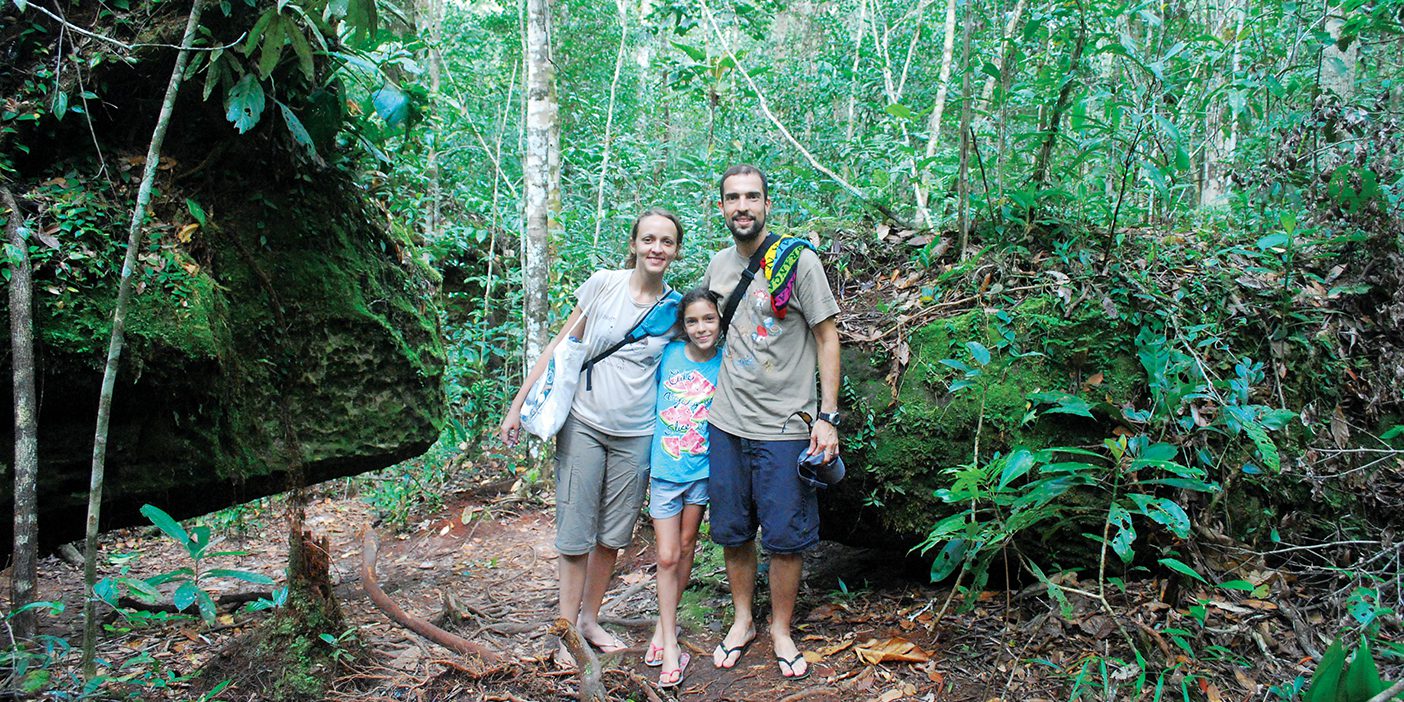Inside Micropolis
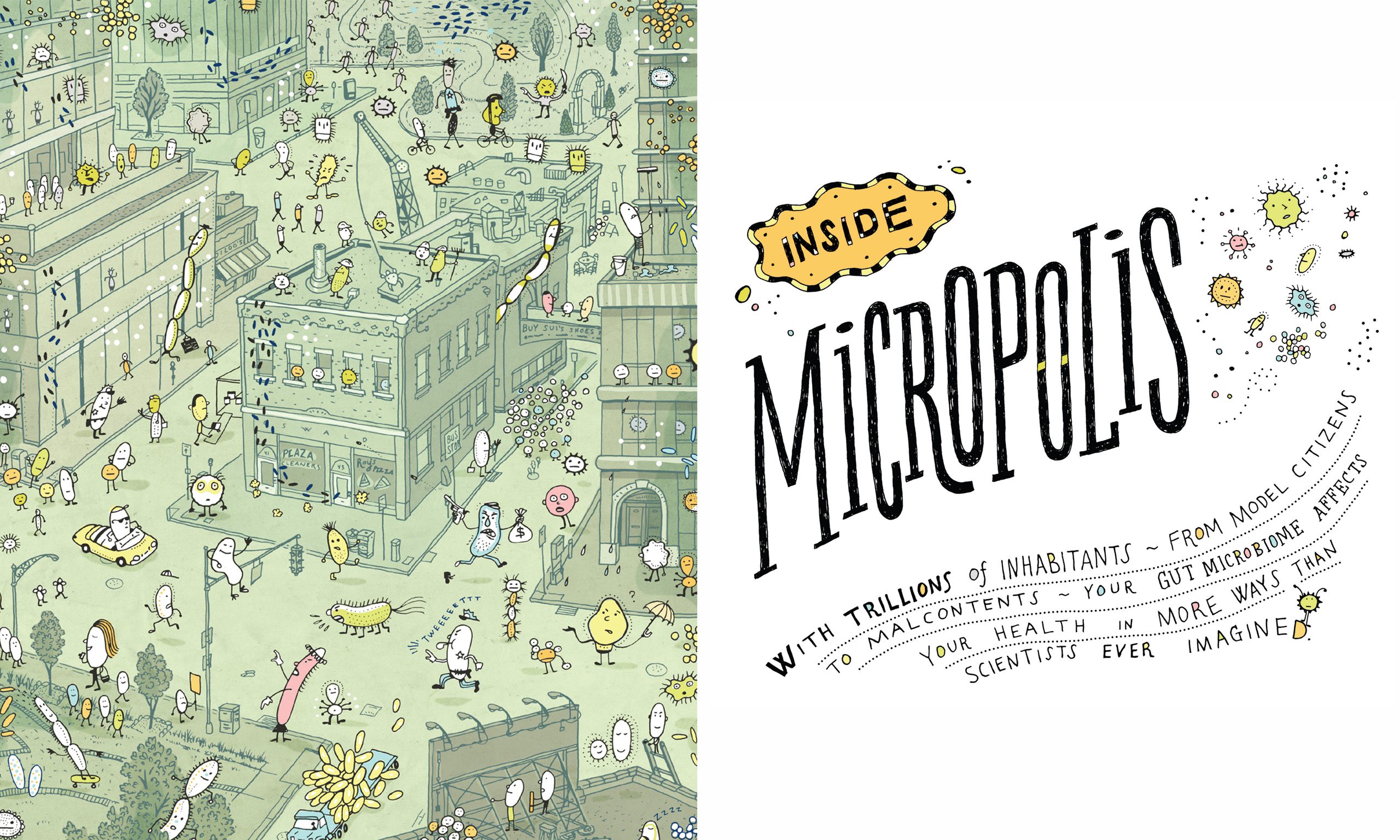
By Amanda K. Fronk (BA ’10, MA ’14) in the Fall 2018 Issue
Illustrated by John S. Dykes
Nearly 40 percent of American adults are obese. By now, we aren’t shocked by this stat, and most of us are tired of talking about it. We live our lives pushing against this fact, forever dieting and exercising and obsessing over our weight. We fret about it on national news, over social media, and in war stories with friends. And yet, for all our talking about this weighty problem, we’re not that great at solving it.
Obesity rates continue rising even as the number of diets and exercise programs increase. We try and we try and we try. And somehow, we gain and we gain and we gain. But maybe, just maybe, it’s not (entirely) our fault.
Consider this: Five years ago, Chinese researcher Liping Zhao and his team at Shanghai Jiao Tong University caused some mice in their lab to transform from healthy to obese in a matter of weeks, putting on four times the grams as their cage mates on a similar diet. How did they do it? By transplanting bacteria from the gut of a 385-pound, morbidly obese human.
When Zhao took a sample of the man’s gut microbiota—the community of bacteria and viruses that live inside human intestines—he was surprised to find 35 percent of it made up of Enterobacter cloacae B29, bacteria rarely found in a healthy person. In an attempt to starve these fat-loving bacteria, the research team placed the subject on a diet full of whole grains and fibrous fruits and vegetables. In 23 weeks, the man lost 113 pounds, and E. cloacae B29 all but disappeared from his gut.
Clearly, the bacteria were tipping the scales toward obesity—for man and mouse. And, as researchers all over the world, including at BYU, are discovering, it’s not just obesity. Bacteria have already been implicated in the development of diabetes, anxiety, depression, multiple sclerosis, Parkinson’s disease, anorexia, and more.
BYU microbiology and molecular biology professor Laura Clarke Bridgewater (BS ’89) took a yearlong sabbatical with Zhao in 2014–15 to explore bacterial connections with stress and anxiety. And since then, she’s been digging into what else these bacteria are doing inside our bodies.
Though we’ve known about the existence of these microscopic organisms for some 330 years, scientists like Bridgewater are just now delving into how non-pathogenic gut bacteria actually interact with the body. “In the last 10 years [the field has] really exploded,” she says. The study of gut microbiota gives a whole new approach for researching ailments and, with it, optimism for discovering new treatments.
Inner-City Relations
You are a walking metropolis, population 39 trillion-ish (and that’s just bacteria—never mind the local viruses). You’ve got diverse neighborhoods filled with productive citizens, devious crooks, and visiting tourists. It’s a bustling, industrious place. The bugs residing within you and on you outnumber all the cells in your body, but they’re so small they amount to only about five pounds of you.
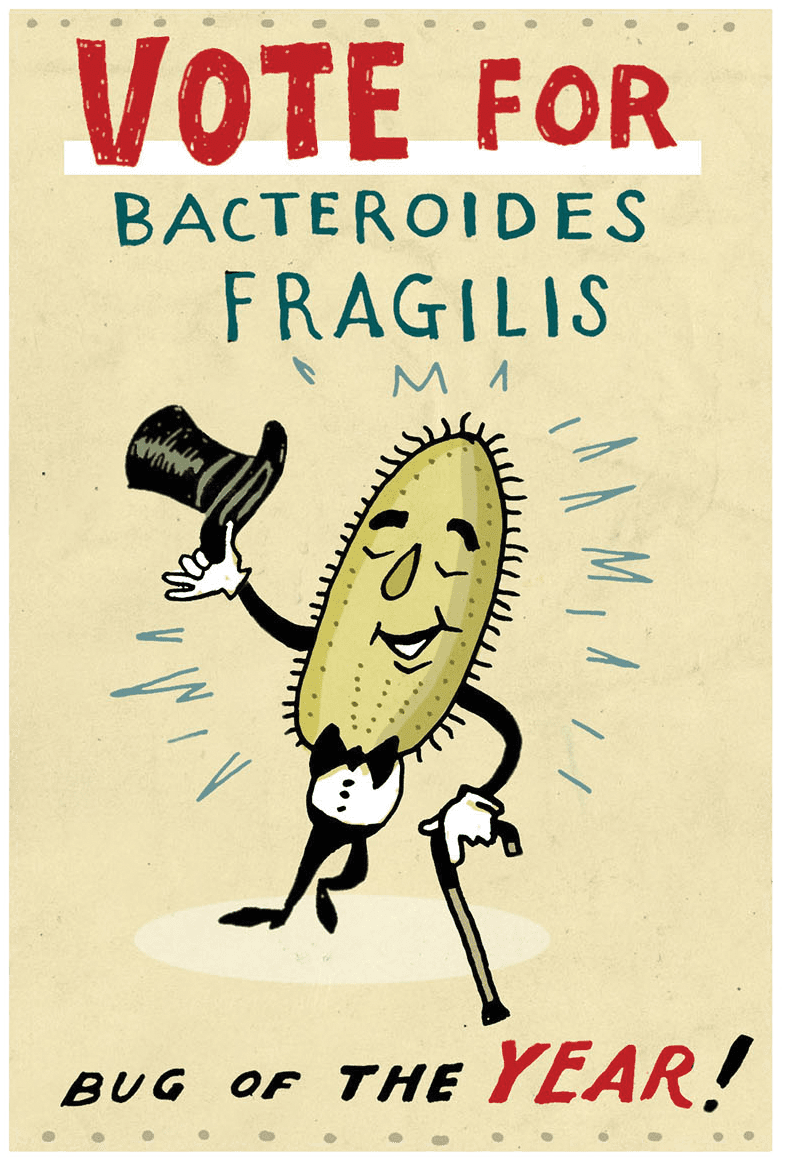
It’s understandable if this view of things gets your skin crawling. Over the years, we’ve framed bacteria as disease-causing enemies. And it’s little wonder why, since the mischief-makers have been known to cause disturbances like pneumonia, tuberculosis, and Lyme disease. And infamous bacteria E. coli and salmonella might as well be crime lords. But it’s a comparatively small portion of bacteria that have given the rest a bad name. Most bacterial citizens just go about their business, and many are even beneficial to your health.
Here’s how the symbiotic relationship works: we provide a warm residence and natural resources (like nutrients and plant fibers); bacteria in turn do things we cannot do for ourselves, like refining those resources into materials that we can use. The resident bacteria have highly specialized jobs, working as carbohydrate digestors, vitamin synthesizers, immune-system strengtheners, and even cell-building instructors.
In a healthy microbial community, good bacteria help keep the peace by crowding out the bad guys. “Having beneficial bacteria colonizing your gut,” says Bridgewater, “you’re less likely to get sick if there’s some bad bacteria in the food you eat because it’s going to be out-competed by what’s already there.”
And then there’s metabolism. “We all know someone who seems to eat anything they want, and they stay skinny,” says Bridgewater. “Somebody else is always dieting, and they’re not losing weight. How is this possible?” The answer, she says, comes down to the varying makeups of our guts.
Even though we’re mostly oblivious to this community within, our bodies nevertheless seem in tune with it, even doing things to promote bacterial growth. For example, why is it that human breastmilk contains so many oligosaccharides, complex sugars that babies cannot digest? Oligosaccharides, it turns out, are like a neon sign to the complex sugar–loving bacterium Bifidobacterium longum infantis, inviting it to take up residence in babies’ intestines. As B. infantis devours the sugars in breastmilk, it releases nutrients to the baby and sends out signals that strengthen the intestinal lining, protecting the baby against infection and disease.
Breeding Bacteria
At birth humans are like a brand-new vacant city, ready to be overrun by bacteria in search of housing and free food. Even before our first breath, we start collecting the microbes, some of which will make their way to the prime real estate of our gut.
What that microbial ecosystem ends up looking like depends on several factors, many from the earliest years: Was it a vaginal or C-section birth? Was the baby breastfed or formula fed? What did the baby eat as a toddler?
Gut populating operates according to first-come, first-served rules. “Once the bacteria are established, it’s pretty stable,” says Bridgewater, who adds that by age 2, the gut is pretty well set up for life and stubbornly resists change. After a course of antibiotics, “there will [initially] be a big difference in the gut microbiota,” Bridgewater says, “but by two or three months later, it’ll [return] completely back to normal, . . . which is good if it’s healthy.” However, if your community of microbiota is troubled—causing a slower metabolism or bringing about illness, for instance—changing it can be a frustrating predicament. But researchers have found a few things that seem to make a difference. See “Building a Healthy Gut” below.
“A comparatively small portion of bacteria give the rest a bad name. Most just go about their business, and many are even beneficial to your health.”
In 2012 the Human Microbiome Project Consortium published its first paper overviewing the nature of human microbes. Many people expected to see a core microbe—“a microbe that’s found in every individual of a particular species at a particular time point,” says plant and wildlife professor John M. Chaston (BS ’05), who studies gut microbiota in fruit flies. What they found instead was nearly endless variety. “There were big differences between individuals—healthy individuals,” he explains, noting that variation in gut flora may be as diverse as the individuals on the planet. “There are people who argue that the microbiome is a distinguishable fingerprint,” says Chaston.
With so many different species of bacteria that can exist in the human gut, scientists have stopped looking for the one perfect, ideal gut out there to replicate. “The emerging model is that function is more important than taxonomy,” says Chaston. In other words, it’s about creating a balanced community that performs all the desired functions for the host, rather than creating a list of specific bacteria. For example, what’s the right ratio of metabolizing bacteria to infection-fighting bacteria? It’s that balance—or imbalance—that ultimately impacts our overall health.
Connecting to Causes
Until recently, medical researchers have analyzed illnesses like obesity, autism, and depression head-on, eyeing such things as metabolic malfunctions or problems with neurotransmitters. The approach has effectively managed the symptoms of many diseases over the years, but with the emerging study of gut microbiota, researchers believe they are closing in on some of the actual sources of the trouble. While most research can only prove correlation and not causation—as with autism—other research has found direct connections between our gut microbiota and disease.
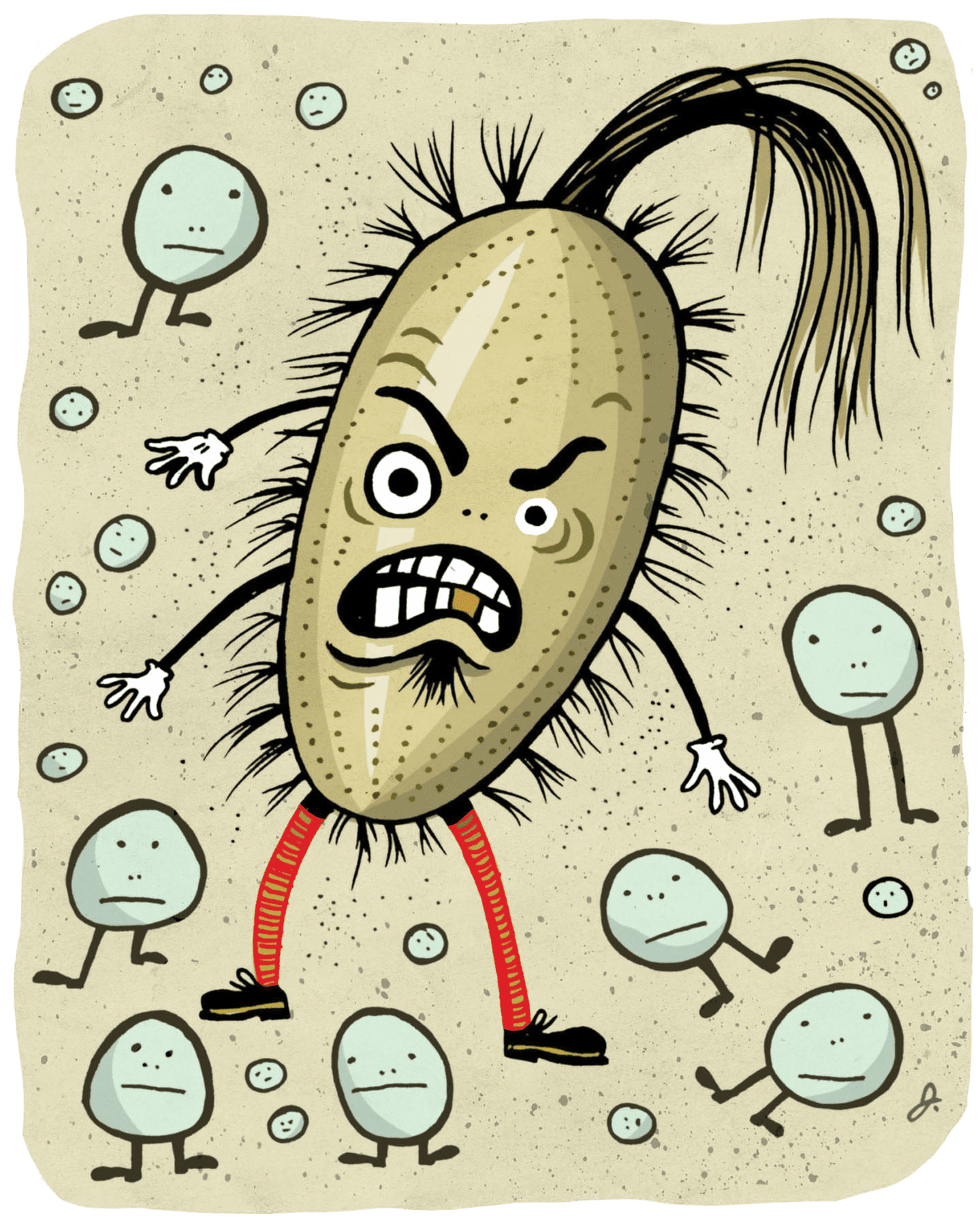
Take the Chinese obesity research, for one. Researchers aren’t sure exactly how Enterobacter cloacae B29 or any other bacterium causes obesity, but there are theories. One is that certain bacteria are masterful at squeezing calories from food. If a person eats “the same food somebody else eats, and their gut microbiota are harvesting more energy from [it],” says Bridgewater, “then it’s as if they were eating more, when they’re really not.” Another idea is connected to the endotoxins that some bacteria release into the bloodstream. At high levels, these endotoxins can cause septicemia and often death, but at very low levels, it could lead to chronic inflammation throughout the body. What does that have to do with obesity? “Inflammation affects insulin signaling,” says Bridgewater. “And if insulin response isn’t working right, then people can be storing fuel that they should be burning.”
Bacteria also appear to play a part in mental illnesses like anxiety and depression. How can your intestines have anything to do with mental illness? First off, “90 percent of the serotonin in our body is actually made in the gut,” says Bridgewater. Serotonin is one of the key neurotransmitters our body uses to keep us emotionally balanced. And second, the vagus nerve, one of the biggest in the body, runs from the brain to the gut’s 100 million neurons.
Anxiety and depression occur when there is an imbalance of neurotransmitters between neurons. “Dopamine, serotonin. . . . They’re human chemicals. Our bodies make them to signal from one nerve to the next,” Bridgewater explains. “But bacteria can also make them. And so if bacteria can make things like that, they might be signaling directly to our neurons.” It’s too early to tell which bacteria or combination of bacteria may be influencing neurotransmitter levels, but as the research continues, Bridgewater is hopeful scientists will find better treatment.
Better Bug Management
What does the future of microbial medicine look like? It’s much more elegant than a slew of indiscriminating antibiotics, says Bridgewater. Her team is currently working on isolating bacteriophages—viruses that target bacteria—that will seek out and kill obesity-causing bacteria. “If we can just selectively remove some of the harmful kinds of bacteria to open up some ecological space,” she says, “then maybe we can give the good bacteria a better chance.”
Bridgewater compares the gut to the perilous Amazonian ecosystem: “If you drop a kitten in the Amazon jungle, it’s really unlikely the jungle’s going to end up overrun by cats. It’s not impossible, . . . [but] probably that kitten’s gonna die.” But if researchers can kill off harmful bacteria, then probiotics will have a better chance of finding space and flourishing.
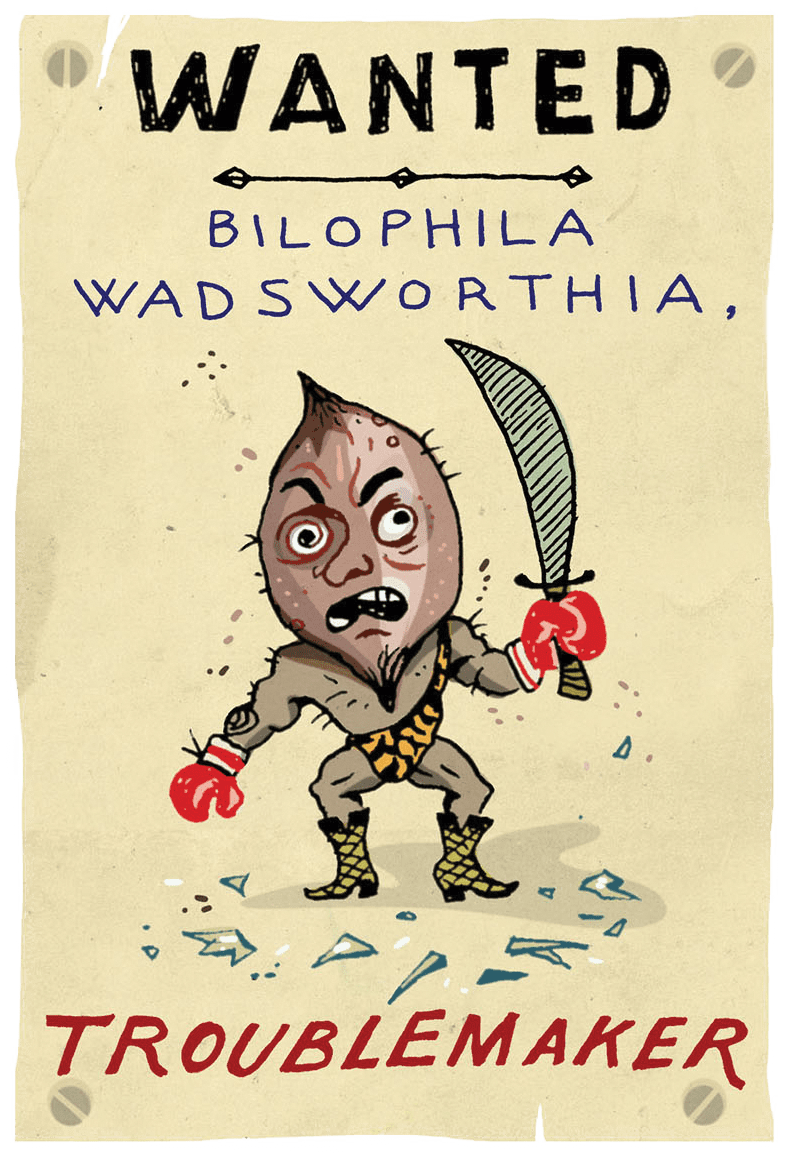
While phage therapy has been used successfully in Russia and Georgia for the past 80 years, it is just starting to be used in the United States in clinical trials. Julianne H. Grose, a microbiology and molecular biology professor who researches bacteriophages, envisions a future where phage therapy will supplement antibiotics. “Antibiotics and phages work by such different mechanisms that most bacteria that become antibiotic resistant are still sensitive to phages,” she says, and likewise some bacteria are better treated by antibiotics.
Scientists are also researching how to better wield the power of bacteria—how to work with them rather than just keep them in check. Doing so could open many a door in the medical field. For one, Chaston says, they are a whole lot easier to change than our genetics. “Once I’m an adult, it’s really hard to replace the genes in every cell of my heart,” he says. “But we know that the microbiome is a really good way to manipulate the host’s traits.” It’s far too early to know how this would be done, but it’s an alluring idea. “We know that we can get people microbes that do things that we can’t engineer our own cells to do,” Chaston explains. “Taking microbes to target specific problems and using them as a therapeutic agent—that seems like an exciting place on the frontier.”
For now, doctors are already using gut microbiota to cure some illnesses. For example, Clostridium difficile is a pathogenic bacteria that causes severe diarrhea and can lead to death. It often occurs after intense courses of antibiotics, which leaves the intestines susceptible to infection. “It’s hard to get rid of. There aren’t good [traditional] treatments,” says Chaston. He calls its cure—a fecal microbiota transplant—“the hallmark of microbiome treatment.” The transplant involves giving “an unhealthy person a healthy person’s poop,” Chaston explains. “We don’t know what’s in it. We just know that they get better.” Some 90 percent of transplant recipients recover, often within mere hours of the transplant.
Whatever the future holds for microbial-related health, it’s clear that these microscopic cohabitants are much more connected to us than we could have ever conceived. For Bridgewater, all the unknowns are a driving force in her research.
“We know that [bacteria] have an impact, but which bacteria are the key players and which are bystanders is still very difficult to determine,” she says. “I’m excited at the prospect of coming to understand which individual bacterial species impact human health, particularly mental health, and exactly how they do it.”
Building a Healthy Gut
When it comes to gut microbiota, BYU microbiology and molecular biology professor Laura Clarke Bridgewater (BS ’89) says that “diversity is better.” The more different kinds of bacteria in a gut, the healthier the person tends to be. While the jury’s still out on what specific blends of bacteria are best, there are ways you can help create this diversity:
Get Dirty. “[Babies] put everything in their mouth. . . . That’s what they do,” says Bridgewater, who adds that this is a good thing. “They actually are building microbiota.” Studies have shown the benefits of letting kids be a little dirty, such as lowering their risk of developing asthma or allergies. “If they get [bacteria while] young, when their whole immune system is developing, their immune system ends up stronger and doesn’t overreact to every little thing,” she says.
Eat Your Greens. “What you feed will grow,” Bridgewater says, which is why diet is so important. “Plant fibers are definitely beneficial for the gut bacteria. They tend to make the best bacteria grow.”
Manage the Stress, Ladies. Bridgewater and her research team found that when female mice are under stress, their gut microbiota are harmed. If the stressful conditions are chronic, the changes may persist. “That suggests it’s worth making the effort to manage and reduce stress,” says Bridgewater, “not just endure it.”
Balance Antibiotics. While Bridgewater readily champions antibiotics as godsends of modern medicine, she recommends using them sparingly and being strategic. And, with the guidance of your doctor, you might consider taking a probiotic.
Be Consistent. To be effective, a high-fiber diet needs to be a lifestyle change. “You can’t just go on a diet for a couple of months, have [your gut microbiome] change, and then go back [to your old diet],” says Bridgewater. “[Your microbiome] will go back, just as quickly.”
Meet Your Bacteria
In the thriving city of our guts, there are trillions of bacteria, living, working, and eating. Some are delinquent troublemakers, causing quick and intense illness, while other bad guys fly under the radar, slowly making us sick without our knowing it. Still others are some of the hardest workers in our bodies, breaking down indigestible nutrients for us to consume and fighting off some of the more nefarious bacteria. Here are a few of the different bacteria that call our gut home:
Bacteroidetes: One of the most common types of bacteria in the human gut, the bacteroidetes are a family (phylum, if you want to get technical) of bacteria that thrive on fiber and complex sugars. They help us break down proteins and carbohydrates. People with high levels of bacteroidetes tend to be leaner.
Firmicutes: The fat-loving firmicutes are also very common. Firmicutes are masters at getting more calories out of food than the body cells could do on their own. They tend to be more abundant in overweight people.
Bilophila wadsworthia: This is one of the criminal bacteria that sometimes find housing in the human gut. Large communities of this bacteria cause irritable bowel syndrome and other digestive problems.
Bacteroides fragilis: If studies with mice hold true for people with autism, the presence of this bacterium may help hosts who struggle with social deficits, anxiety, and repetitive behaviors.
Lactobacillus rhamnosus: Though the effect is not yet proven in humans, this bacterium is believed to be associated with lower rates of anxiety- and depression-related behaviors in their hosts.
Feedback: Send comments on this article to magazine@byu.edu.


